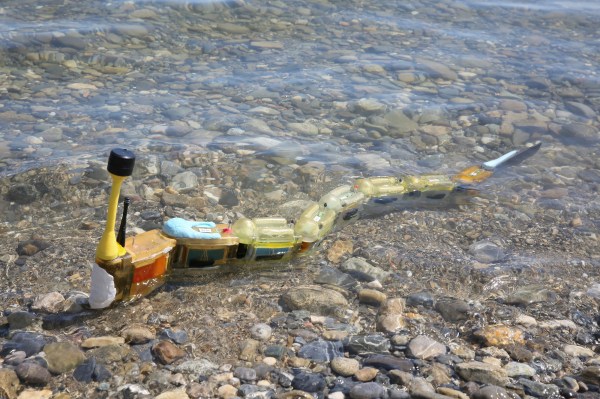The next time you’re swimming in Lake Geneva, don’t be surprised when you feel something eel-like and yet artificial touch your leg. That would be Envirobot, the latest biomimetic creation from Swiss researchers that autonomously swims around bodies of water and tests them for toxins and other factors.
It’s from l’École polytechnique fédérale de Lausanne, which also produced the salamander-like Pleurobot and some convincing imitation reptiles for a BBC nature documentary. But while Pleurobot was about studying animal locomotion and the others were for surreptitiously monitoring wildlife, Envirobot is meant to be a tool for ecologists and other scientists.
The 4-foot creature, or device, whatever you want to call it, is made up of many small segments, each with a specialized purpose but sharing the ability to flex in concert with each other, creating a serpentine motion that propels it through the water.
The head, naturally, is the control center, housing the gear the robot needs to get around — camera, computer and so on. The segments are where the magic happens, though. Inside each cavity are sensors of various kinds: electrical, chemical and biological.
[gallery ids="1518794,1518792,1518793,1518795"]
Electric sensors can track the salinity of the water, and chemical ones obviously can test for acidity or certain elements. The biological sensors are different, though: they’re filled with living organisms or tissues — fish cells, microfauna, etc. — which react in predictable ways to, say, the presence of insecticides or other toxins. (You can see a sensor cavity in the gallery above.)
Envirobot can follow waypoints or swim in a pattern, or it can use feedback from its sensor modules to act on its own, following a salt or toxin gradient in order to find its source. Humans have to transport it over land and deploy it, of course, but once in the water it’s quite autonomous. That makes it an efficient data gatherer, much better than a monitoring buoy or station.
“There are many advantages to using swimming robots,” explained EPFL’s Auke Ijspeert, head of the Biorobotics Laboratory that produced Envirobot, in a news release. “They can take measurements and send us data in real time — much faster than if we had measurement stations set up around the lake. And compared with conventional propeller-driven underwater robots, they are less likely to get stuck in algae or branches as they move around. What’s more, they produce less of a wake, so they don’t disperse pollutants as much.”
Ideally, you would take one or more of these guys, set them loose in some body of water and a couple of hours later get a detailed map of all kinds of factors. Many a biologist, ecologist or civil engineer would like things to be as easy as that.
So far the team has tested the bot in Lake Geneva, for benign substances like salt, and in the lab, for toxins they wouldn’t want to release into the environment.
